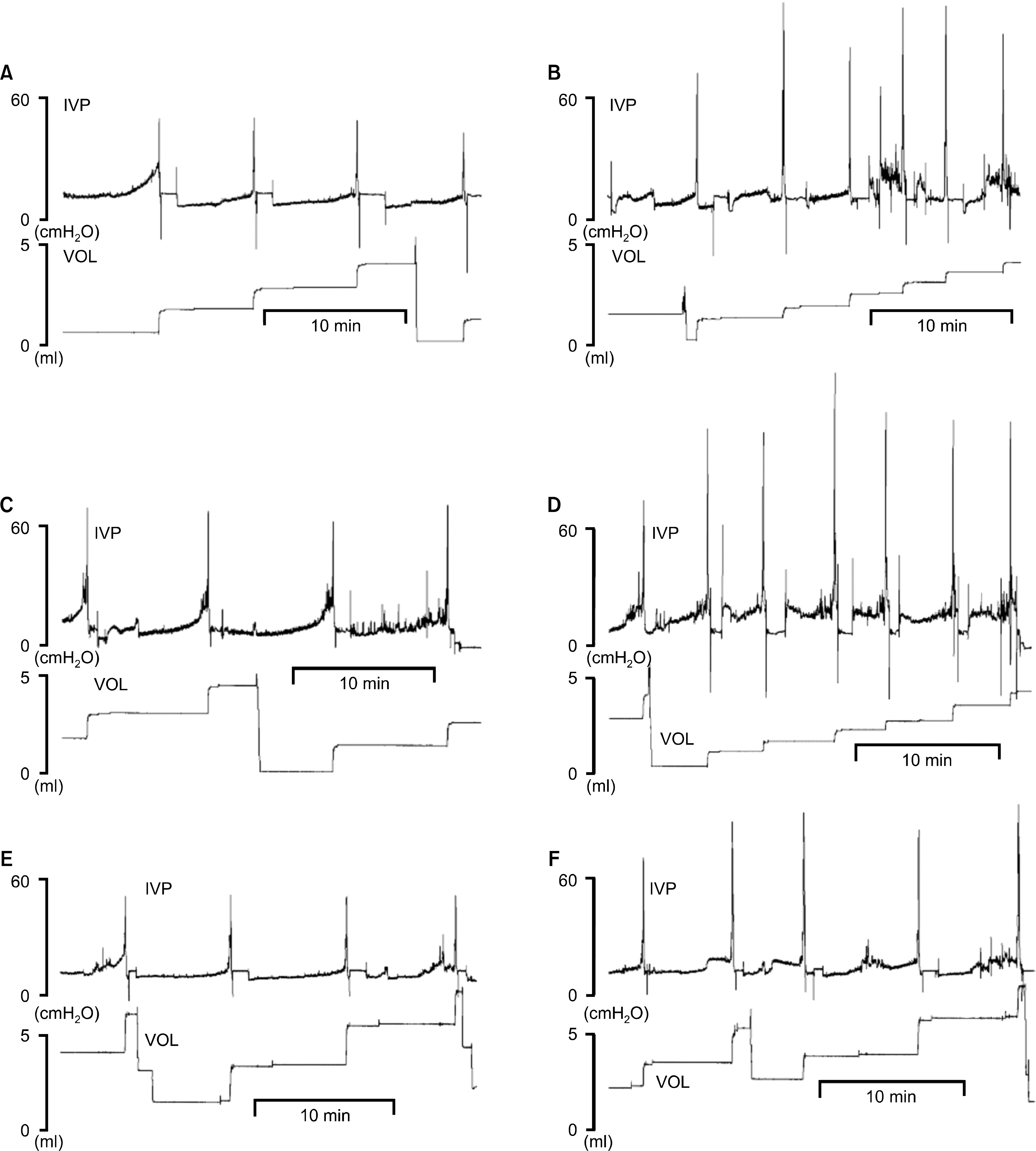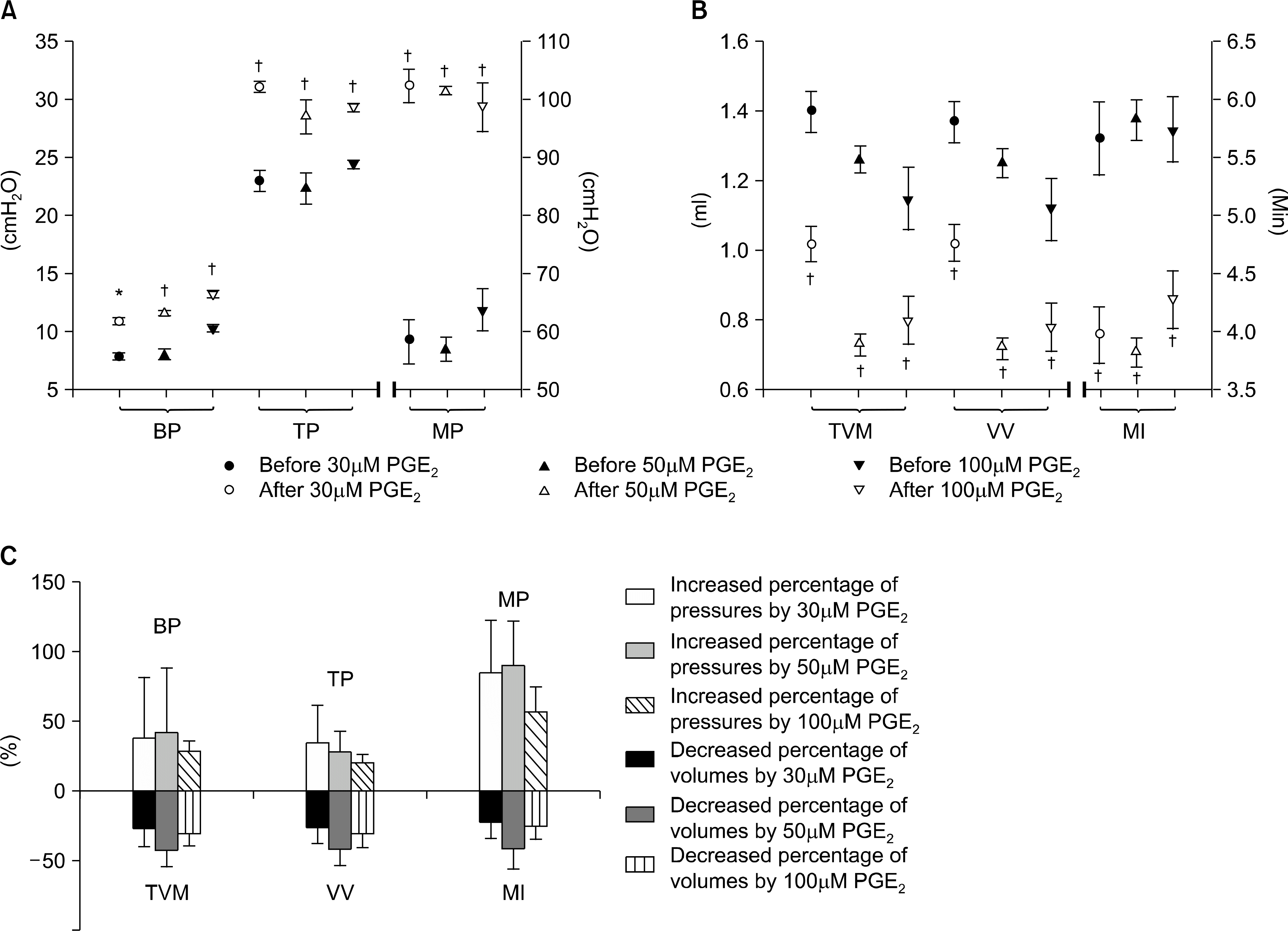Abstract
Purpose
Establishing an appropriate animal model is essential for investigating the yet unknown mechanisms of overactive bladder (OAB). Pro-stanoids are an already well known intrinsic cause of overactive bladder in both animal and human. Awake animal models with prostanoids are already being used as an OAB model, but there is no standardization of methods, and especially for the concentration of the administrated pro-stanoids. So in this study, we tried to objectively establish the standardized concentration of prostanoids and its effect on urination through urodynamic studies with using non-anesthetized Dawley rats.
Meterials and Methods
We divided 18 female rats (215-280g) into 3 groups of six rats each and we injected 30μM, 50μM or 100μM of PGE2, respectively. A catheter was placed inside the bladder through an incision in the abdominal wall. After three days, cystometry was performed with the arts in an awake state. During cystometry, we administrated saline into the bladder to identify the usual voiding status of the rat. In comparison, the saline with PGE2 at 3 different concentrations (30, 50, 100μM) was administrated into the bladder (10ml/h).
Results
Each group of the 30, 50, 100μM PGE2 administered rats showed an increased level of the basal pressure, the threshold pressure and the maximal pressure compared to the state before administration of PGE2. Also, the bladder capacity, voided volume and micturition interval decreased by a statistically acceptable amount, like was seen in the OAB model. There was a trend that showed a greater increase in the pressure parameters and a greater decrease in the volume parameters in the 50μM PGE2 group compared to the 30μM PGE2 group, but there were no differences between the 50μM and 100μM groups.
Conclusions
In the normal awake rats, PGE2 induced overactive bladder to a statistically significant amount for all concentrations (30, 50, 100μM). Among these groups, the concentration of 50μM provoked OAB most effectively, and the higher concentration of PGE2 (100μM) did not provoke a more efficient OAB, which might have been due to the characteristics of the intrinsic material in the bladders. Thus, we recommend PGE2 50μM for efficient induction of OAB.
REFERENCES
2. Andersson KE, Appell R, Awad SA, Chapple C, Druts H, Finkbeiner A, et al. Pharmacological treatment of urinary incontinence. Abrams P, Cardozo L, Khoury S, Wein A, editors. editors.Incontinence. Plymouth: Health Publication Ltd.;2002. p. 481–91.
3. Andersson KE. Overactive bladder-pharmacological aspects. Scand J Urol Nephrol. 2002; 210(Suppl):72–81.

4. Abrams P, Cardozo L, Fall M, Griffiths D, Rosier P, Ulmsten U, et al. The standardisation of terminology of lower urinary tract function: report from the Standardisation Sub-committee of the International Continence Society. Neurourol Urodyn. 2002; 21:167–78.

5. Schröder A, Uvelius B, Newgreen D, Andersson KE. Bladder overactivity in mice after 1 week of outlet obstruction. Mainly afferent dysfunction? J Urol. 2003; 170:1017–21.
6. Takeda H, Yamazaki Y, Igawa Y, Kaidoh K, Akahane S, Miyata H, et al. Effect of ß3-adrenoceptor stimulation on prostaglandin (E2)-induced bladder hyperactivity and on the cardiovascular system in conscious rats. Neurourol Urodyn. 2002; 21:558–65.
7. Meini S, Lecci A, Cucchi P, Catalioto RM, Criscuoli M, Maggi CA. Inflammation modifies the role of cyclooxygenases in the contractile response of the rat detrusor smooth muscle to kinin agonists. J Pharmacol Exp Ther. 1998; 287:137–43.
8. Schröder A, Newgreen D, Andersson KE. Detrusor responses to prostaglandin E2 and bladder outlet obstruction in wild-type and EP1 receptor knockout mice. J Urol. 2004; 172:1166–70.
9. Pinna C, Zanardo R, Puglisi L. Prostaglandin-release impairment in the bladder epithelium of streptozotocin-induced diabetic rats. Eur J Pharmacol. 2000; 388:267–73.

10. Wheeler MA, Hausladen DA, Yoon JH, Weiss RM. Prostaglandin E2 production and cyclooxygenase-2 induction in human urinary tract infections and bladder cancer. J Urol. 2002; 168:1568–72.

11. Palea S, Toson G, Pietra C, Trist DG, Artibani W, Romano O, et al. Pharmacological characterization of thromboxane and prostanoid receptors in human isolated urinary bladder. Br J Pharmacol. 1998; 124:865–72.

12. Morikawa K, Ichihashi M, Kakiuchi M, Yamauchi T, Kato H, Ito Y, et al. Effects of various drugs on bladder function in conscious rats. Jpn J Pharmacol. 1989; 50:369–76.

13. Pandita RK, Fujiwara M, Alm P, Andersson KE. Cystometric evaluation of bladder function in non-anesthetized mice with and without bladder outlet obstruction. J Urol. 2000; 164:1385–9.

14. Pandita RK, Andersson KE. Intravesical adenosine triphosphate stimulates the micturation reflex in awake, freely moving rats. J Urol. 2002; 168:1230–4.
15. Gu BJ, Ishizuka O, Igawa Y, Nishizawa O, Andersson KE. Role of supraspinal tachykinins for micturition in conscious rats with and without bladder outlet obstruction. Naunyn Schmiedeberg's Arch Pharmacol. 2000; 361:543–8.

16. Ishizuka O, Mattiasson A, Andersson KE. Prostaglandin E2-induced bladder hyperactivity in normal, conscious rats: involvement of tachykinins? J Urol. 1995; 153:2034–8.
17. Lee T, Hedlund P, Newgreen D, Andersson KE. Urodynamic effects of a novel EP (1) receptor antagonist in normal rats and rats with bladder outlet obstructruction. J Urol. 2007; 177:1562–7.
Fig. 1.
Representative cystograms of the rats before and after intravesical administration of prostaglandin E2 (PGE2) at varying concentrations. (A) Before 30μM PGE2 intravesical administration. (B) After 30μM PGE2 intravesical administration. (C) Before 50μM PGE2 intravesical administration. (D) After 50μM PGE2 intravesical administration. (E) Before 50μM PGE2 intravesical administration. (F) After 50μM PGE2 intravesical administration.

Fig. 2.
Multiple scatter plots with error bars, showing the pressure (A) and volume (B) parameters before and after various concentrations of intravesical PGE2. (C) The vertical bar chart with error bar showing the increased percentage of the pressure parameters and the decreased percentage of the volume parameters between before and after various concentrations of intravesical PGE2. BP: basal pressure, TP: threshold pressure, MP: maximal pressure, TVM: total volume measured, VV: voided volume, MI: micturation interval. The data is expressed as mean±SEM. The comparisons are made versus before drug administration in each group: ∗: p<0.05, †: p<0.01 Student's t-test (paired).

Table 1.
The effects of an intravesical infusion of PGE2 in normal, conscious rats according to the concentration of PGE2
| BP (cmH2O) | TP (cmH2O) | MP (cmH2O) | BC (ml) | MV (ml) | RV (ml) | MI (min) | |
|---|---|---|---|---|---|---|---|
| Total baseline (n=18) | 8.90±0.42 | 23.36±0.90 | 60.89±3.41 | 1.27±0.07 | 1.24±0.07 | 0.02±0.01 | 7.35±0.40 |
| 30μM PGE2 intravesical administration (n=6) | |||||||
| Before | 8.07±0.32 | 23.13±0.91 | 60.29±4.37 | 1.40±0.06 | 1.37±0.06 | 0.04±0.01 | 8.53±0.37 |
| After | 11.14±0.32∗ | 31.18±0.53† | 111.30±3.67† | 1.02±0.05† | 1.02±0.05† | 0.01±0.00 | 6.55±0.30† |
| 50μM PGE2 intravesical administration (n=6) | |||||||
| Before | 8.20±0.46 | 22.40±1.32 | 58.48±2.35 | 1.26±0.04 | 1.25±0.04 | 0.01±0.00 | 7.88±0.29 |
| After | 11.66±0.25† | 28.66±1.47† | 110.19±0.96† | 0.73±0.03† | 0.72±0.03† | 0.00±0.00 | 4.53±0.20† |
| 100μM PGE2 intravesical administration (n=6) | |||||||
| Before | 10.44±0.28 | 24.54±0.26 | 63.81±3.75 | 1.15±0.09 | 1.12±0.09 | 0.03±0.00 | 5.75±0.28 |
| After | 13.35±0.27† | 29.38±0.32† | 99.00±4.20† | 0.80±0.07† | 0.78±0.07† | 0.02±0.01 | 4.28±0.25† |
∗ PGE2: prostaglandin E2, BP: basal pressure, TP: threshold pressure, MP: micturition pressure, BC: bladder capacity, MV: micturition volume, RV: residual volume, MI: micturition interval. Results are expressed as mean±standard error of the mean. Comparisons are made before and after drug administration in each group: p<0.05




 PDF
PDF ePub
ePub Citation
Citation Print
Print


 XML Download
XML Download